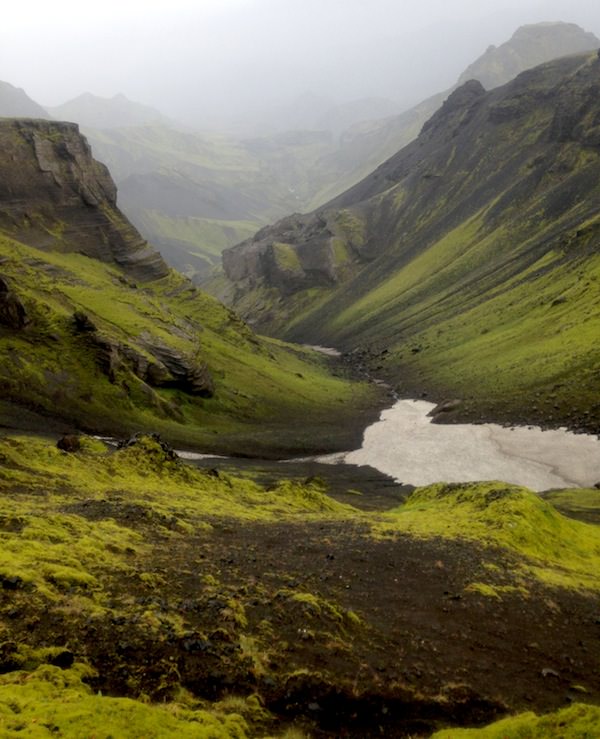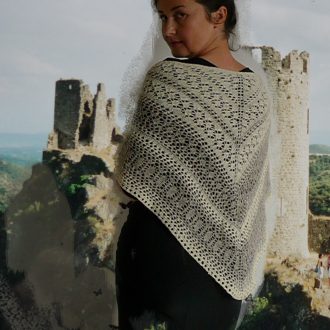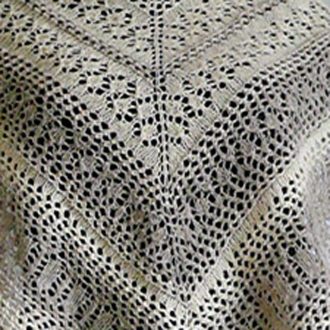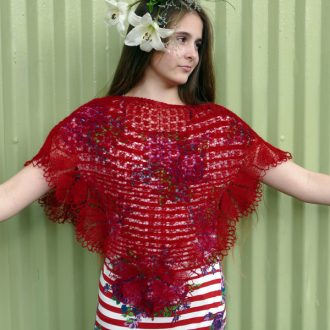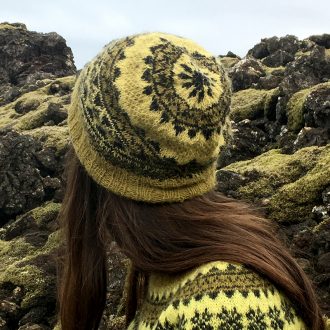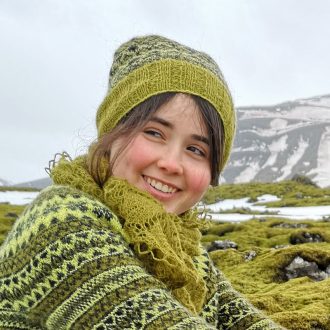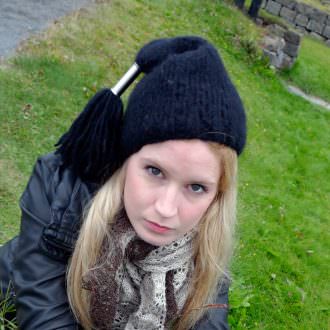Lauf
From € 5,78
Lauf is traditional mittens from the West fjords of Iceland inspired Hélène Magnússon this lovely and colorful top. The band with Leaf motifs at the bottom gave their name to the mittens: “laufaviðarvettlingar”, “Leaf mittens”. Because it’s never that warn in Iceland during summer days, the top is knitted with wool but cotton, linen or a blend with silk would knit beautifully as well!
Yarn used: Kambgarn from Istex
Pattern PDF Download
Orders ship from France (VAT from your country, no Customs fees in Europe) / Commandes expédiées depuis la France (TVA de votre pays, pas de frais de douane en Europe)
“Leaf mittens from the West Fjords inspired me this colurful top. And to be more specific, leaf mittens belonging to Matthildur Guðmundsdóttir, inspired themselves by those from her mother, Sigríður Jakobsdottir.
When I designed the top, I stayed true to the motifs and original colors from Matthildur’s mittens.
First, I stayed true to the motifs and original colors
I later made a second version, much softer, with the newest colors from Ístex and that reminded of colors hand dyed with Icelandic plants. I had to adapt the Leaf motif: it was a 44 stitches repeat and that made it difficult to grade the top, since I wanted the motif to run without interruption around the waist. The shoulders are shaped very nicely with short rows and create a natural neckline at the yoke.”
The Leaf mittens tradition – There are many different types of mittens in Iceland, some typical from some areas of the country or even some families. The oldest Leaf mittens that can be found in Museums in Iceland are from the middle of the 19th century but the tradition is probably much older. Knitting came to Iceland in the 16th century and already in the 17th century you can find leaf patterns in the old Sjónabók (Icelandic pattern books). Why and how it went fashionable in the West fjords, nobody knows really. The mittens, like almost all the knit in Iceland, were knitted in the round on four needles and were, as their name suggests, decorated with a leaf pattern. They were different types of leaves that were given names: fimmtekinn (referring to number 5), sextekinn (to number 6), sjötekinn (to number 7) according to the number of rows needed for one leaf. It was repeated twice so that a man’s mitten would often have a 14 (sjötekinn) rows pattern whereas the women only 10 (fimmtekinn) or 12 (sextekinn) rows. Main color was often in natural colors, brown or white and the leaf pattern was usually yellow or green on a black background. There were smaller patterns, called for example “check”, “small leaf”, “tong” or “twist”, that were used on both sides of the big Leaf motif to get the right size for the mitten. Smaller patterns were also perfect for using the tiny bits of yarns – in those days when no color yarn could be wasted. The small patterns were also used to decorate the thumb. Mittens like this were knitted on very small needles (1,5 mm/ less than 0 US) with a fine band and they were for special occasions.
Design: Hélène Magnússon
Size: slim fit XS(S,M,L,1X,2X)
Finished bust: 71(82,92,102,113,123.5) cm/ 28(32,36,40,44.5,48.5)”
Finished waist: 62.5(73,83.5?94?104?115) cm / 24.5(29,33,37,41,45)”
Body length to armhole: 32(34,36,38,40,42) cm / 12.5(13.5,14,15,16,16.5)”
Needles: circular needle 3 ½ mm / US 4
Gauge: 10×10 cm / 4”x4” = 23 sts x 31 rows over stocking stitch.
Yarn: Kambgarn from Istex 100% merino wool, 3 ply, 150 m, 50gr/skein
MC: shade 1205, 2(2,3,3,4,4) skeins
CC1 to CC5: shades 1206,1210,1211,1217, 9667, less than 20g each;
CC6: shade1212 leftover (cast on).
Black top: colors were discontinued in Mars 2011 but here are some equivalents (the green shade 0969 in the leaf pattern would be the only major change): MC 0059; CC1 to CC5 9664,1214,0969,1215,9667; CC6 1207
Featured samples:
Beige top is a size XS and is a bit big over the breast on the – young! – model.
Black top is first prototype in size M; the length was altered and slightly lengthened.
Techniques: knitting in the round, stranded knitting, intarsia in the round (or alternatively duplicate sts), short rows.
Pattern: once you’ve your paiement, you will receive an email with a link to dowload the pattern PDF. We don’t send patterns by snailmail.
Errata: no mistake was found in this pattern.
| Language | in English, in French, in Icelandic |
|---|

